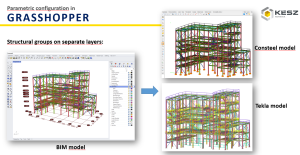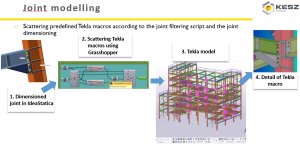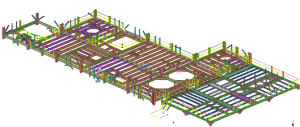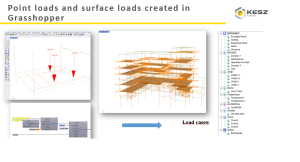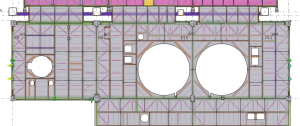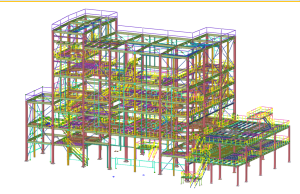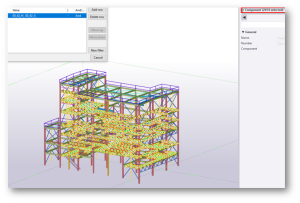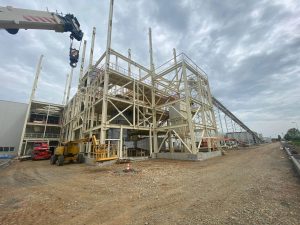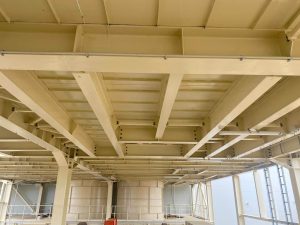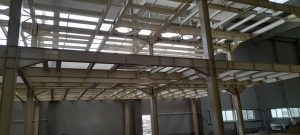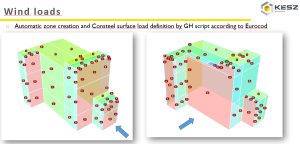 Winnaar van categorie in de landen:
Winnaar van categorie in de landen:
Gipszkarton gyár bővítés

| Categorie | Industriële projecten |
|---|---|
| Jaar | 2023 |
| Land | Romania |
| Organisatie | KESZ Construcții România |
| Auteur | dr. ing. Feleki Attila |
| Co-auteurs | ing. Kis Ádám , ing. András Tünde |
| Cliënt | S.C. SAINT-GOBAIN CONSTRUCTION PRODUCTS ROMANIA S.R.L. |
| Plaats van constructie | Torda, Románia |
| Tags |
A projekt célja a meglévő gipszkarton gyár bővítése, ezáltal 9 új építmény létrehozása.
Ezek az épületek több célt szolgálnak, a nyersanyagfeldolgozástól a szemét tárolásáig. A gyártási folyamatot lekövető és szolgáló épület a malom, mely egy többszintes merev keretszerkezetből felépített acélszerkezet.
Bár a szerkezet geometriája klasszikus formákból épül, amely forma nem feltétlen szükségeltetett parametrikus tervezést, a célunk mégis az volt, hogy parametrizáljuk és egy központi BIM model felépítésével minden adatot egy helyen tartsunk a projekt tervezése folyamán. A központi modell a Rhino-Grasshopper felületekről irányította a teljes tervezési folyamatot.
Figyelembe véve a kapott adatszolgáltatást, itt építettük fel a geometriát, definiáltunk terheket. Az így kapott szerkezet egy kész rúdváz modell volt, melynek globál statikai analízisét a Consteel használatával végeztük.
Kihasználva a Pangolin kétirányú működését, a Consteelben optimizált szerkezettel frissíthettük a központi modellünk.
Következő lépésben a csomóponti statikát végeztük el a Grasshopper-IdeaStatica kompatibilitását kihasználva. Ezáltal típuscsomópontokat szűrtünk (például oszloptoldás, oszlop-főtartó), melyeket a Consteel modellből automatán kigyűjtött igénybevételekre méreteztünk. Ezek az igénybevételek a választott típuscsomópont összes pozicióját megvizsgálva a maximális egyidejű, valamint az abszolút maximum értékek voltak. A méretezett kapcsolatokat egy-egy előre elmentett Tekla makró felhasználásával, Grasshopper segítségével szórtuk ki az összes pozicióra. Így lehetséges volt a födémmerevítők 2074 csomópontjának kiszórására egy kattintás segítségével. Ezzel a módszerrel több mint 3800 Tekla makrót szórtunk ki Grasshopper vezérléssel.
A csomópont méretezési és modellezési időből 40-60%-ot nyertünk ennek a folyamatnak köszönhetően.
The project expands an existing plasterboard factory, by adding 9 new buildings.
These buildings will serve different technological purposes, from raw material processing to waste storage. From technological standpoint, the mill building is responsible for the production process, and consists of a multi-storey rigid frame steel structure.
Although the geometry of the building can be interpreted as a classical shape, which does not necessarily require parametric design, our goal was to parameterize it and keep all the data in one place during the design of the project by building a central BIM model. The central model managed the entire design process from the Rhino-Grasshopper interface.
Being an industrial building, where the technology enjoys the main priority, we built the geometry based on the general loading data coming from the equipments. This process resulted in a 3D structural model composed of beam frame elements. In the next step, this model has been analyzed using Consteel structural design software.
Focusing on the benefits of Pangolin’s flexible compatibility aspects, we could update and synchronise our central model with the optimized structure in Consteel.
After this, we performed the joint design using the Grasshopper-IdeaStatica contact. In this way, we filtered typical joints (e.g. column-splicing, column-main beam), which were dimensioned to the automatically extracted internal forces from the Consteel model. These forces were the maximum simultaneous, as well as the absolute maximum values for all positions of the selected joint. These final connections were spread over all positions using predefined Tekla macros using Grasshopper. Thus, it was possible to automatically position 2074 joints of the strut beams with a single click. Using this method, more than 3800 Tekla macros were spread using the Grasshopper code.
Thanks to this process we have gained 40-60% of the joint sizing and modelling time.
 Winnaar van categorie in de landen:
Winnaar van categorie in de landen:

